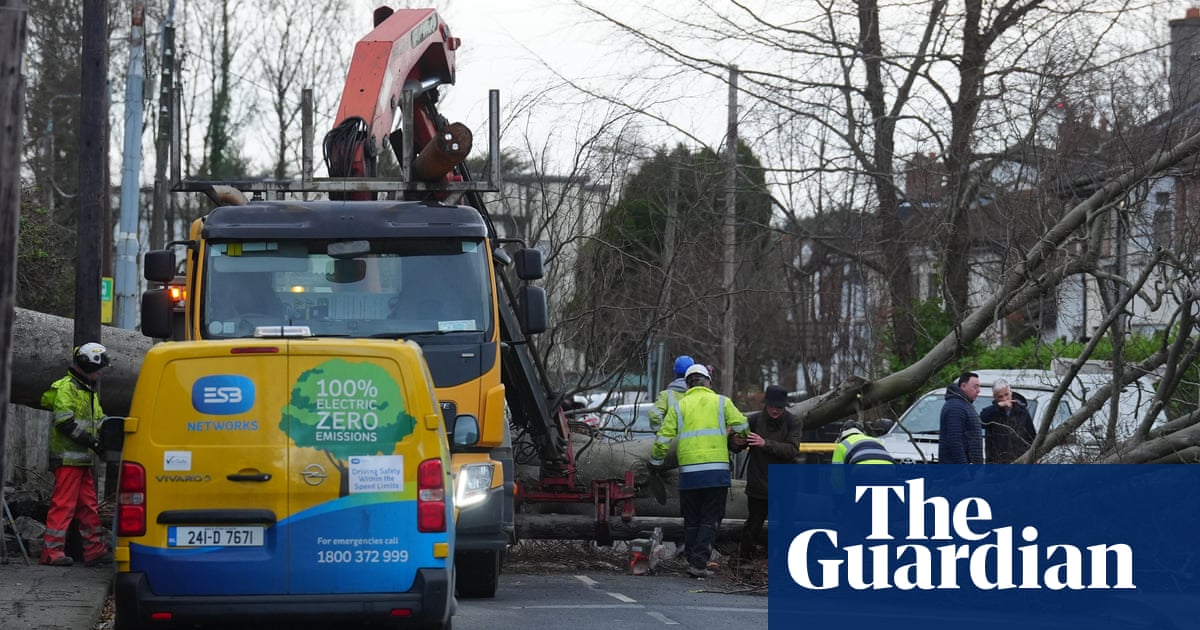
Nearly a million properties are without power across the island of Ireland after Storm Éowyn swept in strong gusts that damaged buildings and blocked roads.
A man died after a tree fell on his car in County Donegal on Friday and fallen trees and debris blocked a number of main roads across Northern Ireland, the Republic of Ireland and Scotland.
A record-breaking wind speed of 183kmh (114mph) was measured in Mace Head, County Galway in Ireland, Met Éireann said.
Further wind and rainfall is forecast. Some places could get up to 80mm of rainfall while 10mm to 20mm should fall quite widely and 30 to 50mm could fall over high ground. The Met Office has issued several amber and yellow weather warnings over Saturday and Sunday.
Yellow snow and ice warnings are in place in Northern Ireland until 10am on Saturday and in Scotland until 11am. Up to 10cm of snow could develop on high ground in Scotland throughout the morning.
A yellow ice warning covering parts of south-west England, the Midlands and southern and mid-Wales will be in place until 10am.
ScotRail said all services across Scotland would remain suspended until midday on Saturday at the earliest.
About a million homes, farms and businesses in the Republic and Northern Ireland were left without power on Friday.
ESB Networks said 725,000 customers were affected in Ireland and NIE Networks said 283,000 were hit in Northern Ireland at the height of the outages.
Tens of thousands have since been reconnected but NIE Networks said it could take up to 10 days to reconnect others.
Utility company Uisce Éireann said about 138,000 people had no water as of Friday evening, and a further 750,000 people’s supplies were at risk.
A total of 235 flights were cancelled at Dublin airport while structures, including a multimillion-euro indoor playing facility in County Mayo, were severely damaged during the storm.
Northern Ireland’s Department of Infrastructure said more than 1,800 objects had blocked roads, and that teams would work to clear them once weather alerts had lifted.
The PSNI assistant chief constable Davy Beck said it would take days to assess the full impact of the “severe” storm.
“We’re only now starting to see the number of calls start to rise in respect of impacts, concerns for safety, and indeed, more and more reports in respect of roads blocked and issues as a consequence of that,” he said.
“So I think it’s going to be a number of days before we can fully understand the full impacts of this storm but certainly this was a severe storm.”
On Sunday, a yellow wind warning covering south-west England, English and Scottish coasts around the Irish Sea, Wales and Northern Ireland will be in place from 8am to 3pm, with 50 to 60mph gusts expected widely in the warning area.
A yellow rain warning covering southern and central England and Wales will also be in place from 8am on Sunday to 6am on Monday.
The Met Office meteorologist Jonathan Vautrey said: “Looking at Sunday, it’s set to be a fairly fine start for a lot of areas – another ridge of high pressure building in to keep things fairly settled, with some sunny spells in there.
“The cloud, though, is going to be building as we see a low pressure system move into the south-west. This will be bringing heavy rain in for south-west England and Wales from sort of mid-morning onwards, and then that will spread into Northern Ireland and northern England as we head later on into the afternoon.
“Winds will also be picking up with this feature. Certainly, it’s not going to be as strong as Storm Éowyn. However, because it’s coming in from the south-west, it’s going to be actually more southern areas of England that are going to see the strongest wind gusts compared to what has mostly been further towards the north.”
Source: theguardian.com


















